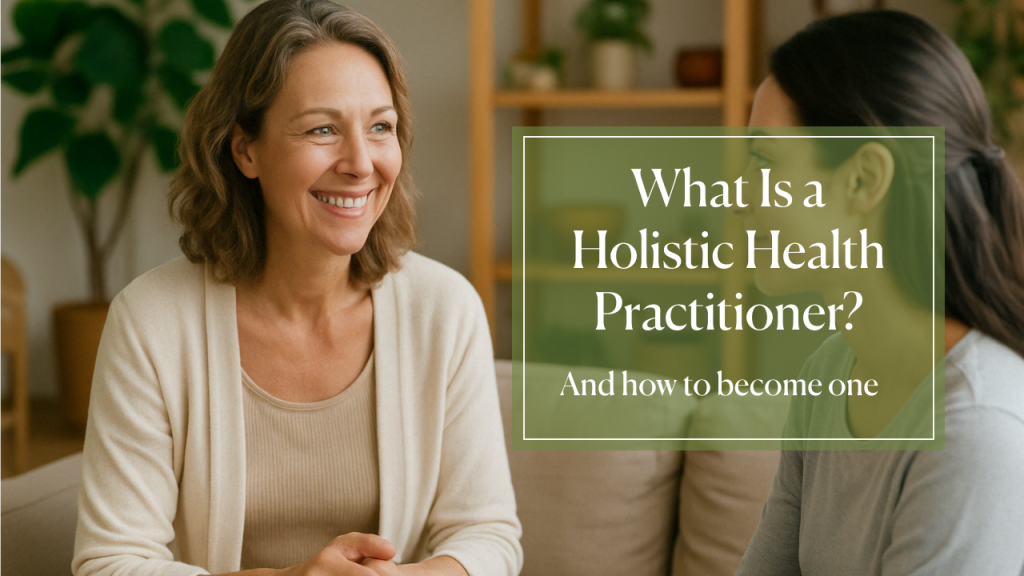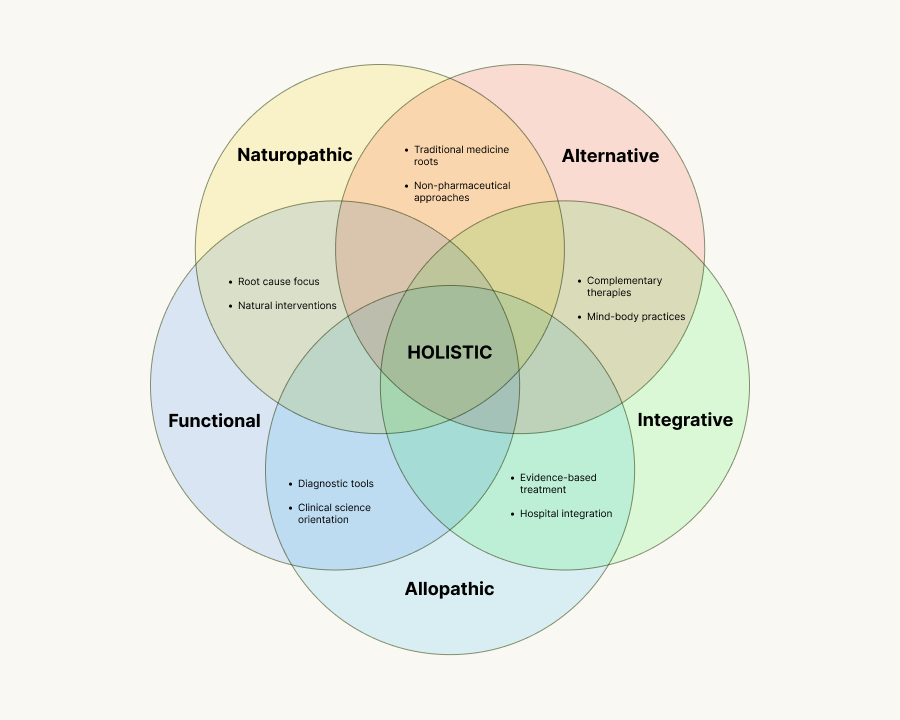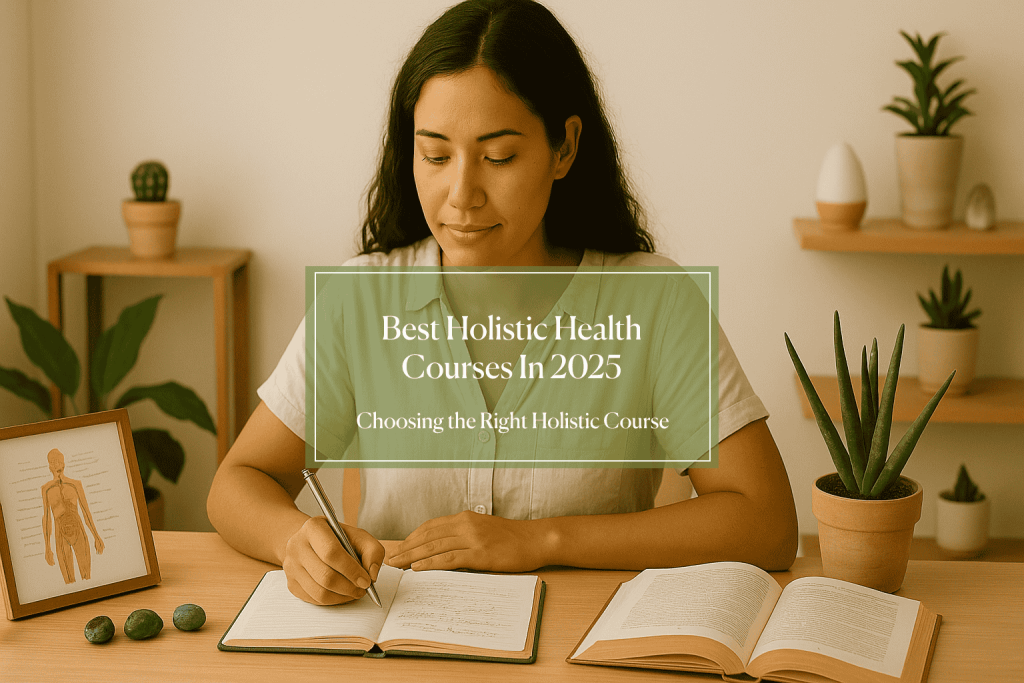What Is a Holistic Health Practitioner? Definition, Role & How to Become

Table Of Contents
A Clear, Comprehensive Look at One of the Fastest Growing Roles in Wellness
In recent years, the phrase holistic health has moved from the margins to the mainstream. But despite its growing visibility, confusion remains around what it truly means—and more importantly, who’s qualified to practice it.
This guide is designed to answer that question thoughtfully, objectively, and in depth.
We’ll explore the role of the Holistic Health Practitioner, how it compares to other professions, what scope of practice is involved, and why it may be one of the most promising and pragmatic paths in today’s evolving health landscape.
What Is Holistic Health?
Holistic health is not a treatment, but a way of seeing. It understands health not as the absence of disease, but as the presence of balance—across body, mind, spirit, and beyond.
It’s built on the idea that every aspect of a person’s life—emotions, lifestyle, environment, beliefs, habits—is interwoven. Disruption in one area often creates ripple effects elsewhere.
In practical terms, holistic health focuses less on symptoms and more on underlying patterns. Instead of asking “How do we stop this pain?” it asks “What conditions allowed this pain to arise in the first place?”
It’s not anti-medicine. But it is often post-medicine—called upon when people seek deeper understanding, long-term change, or answers that don’t arrive in a pill bottle.
How Holistic Health Compares to Other Wellness Models
In a crowded wellness landscape, terms like integrative, alternative, functional, and naturopathic are often used interchangeably. But each has its own orientation and scope.

Allopathic (Conventional) Medicine
This is the dominant model in most countries and includes licensed physicians, hospitals, pharmaceuticals, and surgical interventions. Allopathic care is highly effective for acute illness, emergencies, and conditions that require immediate, measurable intervention. It relies on standardized diagnostics, symptom suppression, and treatment protocols—often addressing illness at the level of pathology rather than behavior, belief, or environment.
However, conventional care can struggle with complex, chronic, or diffuse issues—especially when symptoms don’t point to a clear diagnosis, or when emotional, energetic, or existential aspects of health are involved.
Alternative Medicine
Generally refers to practices used instead of conventional care. These may include herbal remedies, acupuncture, or homeopathy. Some systems are ancient and highly developed; others are modern and niche. The focus is typically on physical treatments—less often on psychological or existential factors.
Functional Medicine
A data-driven, root-cause approach typically practiced by MDs or licensed clinicians. It often uses lab testing and diagnostic models to address complex chronic conditions. Functional medicine is rooted in systems biology, but may not always explore the emotional or energetic aspects of health.
Integrative Medicine
A blend of conventional and complementary methods—typically used within hospitals or clinics. This approach includes therapies like yoga, massage, or meditation alongside standard treatments, often overseen by licensed providers.
Naturopathy
Centered on natural remedies, lifestyle medicine, and prevention. Naturopathic doctors (NDs) are licensed in many regions, trained to diagnose and treat with both modern and traditional methods. However, naturopathy’s emphasis on natural substances may not fully address energetic or existential dimensions of health.
Holistic Health
Holistic health isn’t defined by a single method—it’s a broader lens that considers the full human experience: physical, mental, and spiritual. Rather than aligning with one tradition or toolset, it provides a flexible framework that can incorporate elements from many models of care.
A holistic practitioner may draw from conventional science, natural medicine, and traditional wisdom alike—but the focus remains on the person, not the technique. The goal is integration, not allegiance. What matters is not what’s used, but how thoughtfully it’s applied to support balance, coherence, and long-term well-being.
Some programs, such as the Holistic Health Practitioner Certification by Scholistico, expand this approach even further—introducing structured models that include not just mind, body, and spirit, but also emotional and energetic domains as separate, deeply relevant dimensions of health.
What Does a Holistic Health Practitioner Actually Do?
A Holistic Health Practitioner works with clients to improve overall well-being by addressing the conditions that shape health—not just physically, but psychologically, emotionally, and behaviorally.
A Holistic Health Practitioner doesn’t treat disease, diagnose, or prescribe.
Instead, Holistic Health Practitioners guide individuals in making meaningful, sustainable changes that support vitality and balance over time.
Their work often includes:
- Conducting full-person wellness assessments
- Identifying lifestyle, emotional, and environmental contributors to imbalance
- Guiding breathwork, nervous system regulation, and mindfulness
- Providing education around nutrition, movement, rest, and resilience
- Supporting spiritual clarity, values alignment, or purpose discovery
- Helping clients build customized wellness plans that reflect their whole life
No two Holistic Health practitioners work the same way. The strength of the field lies in its adaptability and personalization—not in protocol, but in presence.
This role is not a simplified version of a doctor or therapist. It’s something different: a companion in self-understanding, change, and restoration.

Why the World Needs Holistic Health Practitioners Now
As healthcare systems become more stretched, a familiar pattern emerges: patients fall through the cracks.
They show up to the doctor’s office with persistent fatigue, anxiety, digestive discomfort, poor sleep, or a vague sense of malaise—only to be told that everything looks “normal.”
And while that may be physiologically true, it’s not functionally reassuring.
If you’ve ever been sent home with “nothing wrong,” you know how disorienting it is. The concern is real. The discomfort is real. And still, you leave without answers—often with a deeper sense of disconnection from your own body.
This isn’t the fault of the doctor. It’s a consequence of a system where the average primary care visit lasts just 10–15 minutes, and where providers are under pressure to prioritize urgency and efficiency over nuance and exploration.

Conventional Healthcare Is Too Rushed for Whole-Person Care
This is precisely where Holistic Health Practitioners step in—not to replace clinical care, but to restore the space for care that requires time, attention, and trust.
Holistic Health Practitioners do what most medical providers simply don’t have the capacity to do:
- Sit with a client for 60–90 minutes
- Explore lifestyle, emotional, energetic, and environmental contributors
- Ask deeper questions about stress, routines, purpose, and relationships
- Trace patterns across mind, body, and life context
- Validate the client’s intuition: “Something feels off, and that matters.”
They offer a layer of relational care that is nearly absent in modern systems. And that care is not vague—it’s structured, ethical, and designed to help the person connect the dots in a meaningful way.
Fragmented Solutions Leave Many Clients Without a Path Forward
A conventional doctor may dismiss concerns that don’t present measurable risk. A talk therapist might hear the same concerns and interpret them purely through a mental health lens.
In both cases, the client is often left with fragmented care and no clear path forward.
Holistic Health Practitioners provide a bridge:
- Between physical and emotional
- Between intuition and data
- Between medical authority and personal agency
They take the full experience seriously, and they work with the individual—not just the individual’s symptoms.
This isn’t theoretical. It’s the lived reality of many Holistic Health Practitioners working outside conventional systems. When someone is seen, heard, and understood, they tend to make better choices, recover more quickly, and engage more fully in their healing process.
Holistic Health Practitioners Fill the Gaps Between “Fine” and “Unwell”
The role of the Holistic Health Practitioner isn’t about making grand claims or overstepping medical boundaries. It’s about filling a very real, very visible void in the care model we currently have:
The space between “you’re fine” and “you’re unwell.”
The space between “watch and wait” and “let’s intervene.”
The space between being dismissed and being understood.
And for thousands of people every day, that space is where healing actually begins.
Are Holistic Health Practitioners Legitimate?
This is an important and fair question. The short answer is: It depends on the training, the ethics, and the scope.
Because the field is largely unregulated, quality varies. But that doesn’t mean legitimacy is absent. In fact, many well-trained practitioners are some of the most thoughtful, disciplined, and humble professionals in the wellness space.
What matters is not the title alone, but how the Holistic Health Practitioner role is practiced.
A legitimate Holistic Health Practitioner:
- Respects boundaries between support and treatment
- Understands their non-clinical scope—and stays within it
- Seeks ongoing training, not just a single certification
- Uses frameworks grounded in systems thinking, not guesswork
- Avoids making promises or guarantees about outcomes
- Knows when to refer out or collaborate with licensed providers
And perhaps most importantly, they do no harm.
Most interventions are lifestyle-based, non-invasive, and gentle—making the risk of side effects low, and the potential for positive change high.

A Flexible Pathway: Practice Early, Specialize Gradually
Unlike tightly regulated clinical roles, the path of the Holistic Health Practitioner is uniquely flexible.
Many begin with generalist training, offering foundational support across stress, fatigue, nutrition, emotional awareness, and lifestyle. Over time, they refine their focus.
Some specialize in:
- Women’s hormonal health
- Gut-brain connection
- Burnout and nervous system repair
- Emotional resilience after trauma
- Lifestyle design for chronic illness
- Holistic parenting or caregiving
Others integrate additional certifications in:
- Nutrition and detox
- Sound therapy or somatic work
- Herbalism or energy medicine
- Movement therapy or mindfulness education
This modularity allows practitioners to build careers that reflect their values, passions, and personal evolution.
Misconceptions About Holistic Health Practitioners
Because the term holistic is used widely—and often loosely—there are many misconceptions about what Holistic Health Practitioners actually do. Some of these come from within the wellness world, and others from outside it. Addressing these misunderstandings helps clarify the true value and scope of the profession.
Misconception 1: Holistic Practitioners Are Anti-Science
In reality, many trained Holistic Health Practitioners actively engage with scientific research—especially in areas like stress, nutrition, behavior change, and somatic awareness. While some draw from traditional or non-Western healing frameworks, the majority recognize the importance of evidence-informed practice and do not reject modern medicine.
Misconception 2: They Try to Replace Doctors
A legitimate Holistic Health Practitioner does not diagnose illness, prescribe treatments, or interfere with medical advice. Their role is to educate, support, and empower clients within a non-clinical framework. They often help clients make sense of their options and refer them back to licensed providers when appropriate.
Misconception 3: The Practice Is Based on Belief, Not Skill
While the field includes a wide range of modalities—some scientific, some spiritual—a well-trained practitioner is grounded in structured methodology. They work with systems thinking, behavioral tools, and self-regulation techniques, not just intuition or personal beliefs. Their work is adaptable, but not improvisational.
Misconception 4: Anyone Can Do It Without Training
This is one of the most damaging ideas in the space. While there are no formal licensure requirements in most regions, ethical practice absolutely requires training—ideally through an accredited certification program that teaches scope of practice, boundaries, and practical application.
At its best, holistic health and the work of a Holistic Health Practitioner is neither fringe nor inflated—it is simply a return to relationship-centered care that treats people as whole, complex beings.
Who Becomes a Holistic Health Practitioner?
Because the role is accessible, modular, and philosophy-driven, Holistic Health Practitioners come from a wide range of backgrounds. What they often share is a deep desire to support others—without needing to fit inside a rigid or medicalized model of care.
Some of the most common paths include:
- Career Changers – Individuals transitioning from healthcare, education, corporate work, or high-stress professions who want to do more meaningful work while maintaining autonomy.
- Wellness Professionals – Yoga instructors, coaches, massage therapists, doulas, and others who want to expand their toolkit with an integrated, whole-person approach.
- Caregivers and Parents – People who have supported loved ones through illness or stress and want to translate that experience into a more structured role.
- Self-Healers – Those who have navigated their own complex health journeys and now want to help others do the same—without becoming a licensed clinician.
- Community Leaders and Educators – Individuals drawn to group facilitation, public health education, or spiritual support, seeking a framework that honors both science and intuition.
What unites these diverse Holistic Health Practitioners is not a particular credential or ideology—but a commitment to care, discernment, and ongoing learning. They don’t need permission to begin helping—but they do take the responsibility seriously.

How to Become a Holistic Health Practitioner
Becoming a Holistic Health Practitioner doesn’t follow a rigid or universal path. Because this is a non-licensed, non-clinical role, the process varies by country, training provider, and personal context. Still, there is a common framework—a progression of considerations and decisions—that defines how most practitioners enter the field.
This section outlines those key stages, not as strict requirements, but as a globally relevant orientation to the journey.
1. Understand the Legal Landscape Where You Live
The first step is understanding what’s legally permitted in your country or region. While the title “Holistic Health Practitioner” is often unregulated, related terms like “therapist,” “naturopath,” or “counselor” may be protected under local law.
In the United States, most states allow individuals to use the HHP title and work in non-clinical roles as long as they don’t diagnose or treat disease, prescribe medication, or present themselves as licensed providers. In Canada, the UK, Australia, and throughout much of Europe, the principles are similar—though it’s important to be aware of which professional titles are reserved for licensed clinicians.
Some countries, like Germany or India, have partially integrated complementary health into their broader systems, while others provide wide latitude for non-clinical wellness professionals. Wherever you’re based, the key is to maintain transparency and stay within a scope that emphasizes education, support, and wellness—not treatment.
2. Choose a Credible, Ethically Grounded Training Program
Without a licensing body, the integrity of a Holistic Health Practitioner training is paramount. A reputable program will provide a well-structured curriculum rooted in whole-person health, not just a collection of isolated techniques. It should address philosophy and frameworks, teach safe and practical tools, and clearly define ethical boundaries.
The best programs go beyond information—they offer support, reflection, and the tools to build a grounded, adaptable practice. Accreditation by internationally recognized bodies such as IPHM, CMA, or NCCAP can help signal that a program meets accepted standards in the wellness field.
Look for programs that balance theory with application and help you think critically about the role you’ll play. Your training should prepare you not only to support others, but to do so safely, respectfully, and within your level of competence.
3. Select a Learning Format That Matches Your Life
Training formats vary widely, and that’s part of what makes the holistic path accessible. Many programs are fully online and self-paced, making them ideal for working professionals, parents, or international students balancing other commitments. Others offer live virtual classes, cohort-based experiences, or immersive in-person retreats.
The best choice is the one that supports your learning style and aligns with your circumstances—not just your aspirations. If you’re highly self-motivated, a well-designed online program may offer the most flexibility. If you learn best through discussion or group interaction, look for live mentorship or cohort-based options.
Some programs allow for modular study, where you begin with core training and later add specializations or deeper study in areas like nutrition, somatic work, or energetic healing.
4. Begin Practice Within a Defined, Non-Clinical Scope
Upon completing your training, you’ll be ready to begin offering services—typically in an educational, coaching, or consultative role. This might involve one-on-one client work, group facilitation, workshops, or creating digital resources to support wellness.
The key is to stay within your lane: focus on guidance, empowerment, and lifestyle support—not clinical diagnosis or treatment. Make your scope clear in your communications, disclaimers, and contracts. The more transparent you are about your role, the more trust you build with your clients—and the more secure your practice becomes.
5. Deepen Your Skills and Specialize Over Time
One of the defining features of the HHP path is its flexibility. Unlike licensed professions that require major recredentialing for each specialization, holistic practitioners can continue to evolve their scope organically—building on what they’ve learned and responding to the real needs of their clients or communities.
Some practitioners go on to specialize in areas such as digestive health, nervous system regulation, burnout recovery, sound therapy, women’s health, or trauma-informed care. Others develop offerings around specific populations—like caregivers, creatives, or those navigating chronic conditions.
Specialization can take the form of additional certifications, mentorship, or years of hands-on experience. What matters is that your learning deepens, your perspective sharpens, and your scope evolves with integrity.
6. Consider Joining a Professional Association
While not mandatory, many holistic health practitioners choose to join professional associations that offer directories, continuing education, and access to liability insurance. These associations help establish professional credibility and provide connection to a broader community of practice.
Associations also often serve as a resource for scope clarification, documentation standards, and client communication best practices. For new practitioners especially, this kind of structure can help reinforce both confidence and accountability.
We explore how to obtain professional liability insurance as a holistic health practitioner in a dedicated guide, including what types of coverage are available in different regions and how it reflects growing recognition of the profession.
Do holistic health practitioners need a license?
In most regions, no—provided they operate within a clearly defined non-clinical scope of practice focused on education, wellness, and lifestyle support.
What certifications are respected internationally?
Look for programs accredited by organizations like IPHM, CMA, NCCAP, and other professional wellness bodies.
How long does it take to get certified?
Most programs range from several weeks to a few months, depending on intensity and structure. Scholistico’s program is self-paced and includes lifetime access.
Can I work remotely?
Yes. Many holistic health practitioners work virtually with clients across the globe, especially in wellness coaching, education, and program design.
Is this a real career?
It can be. Success depends on your training, your focus, and your ability to serve real human needs. For many, it becomes a deeply meaningful, values-aligned vocation.








Responses